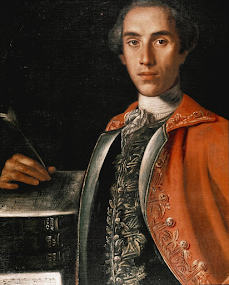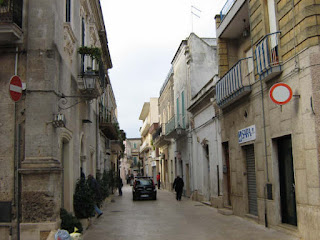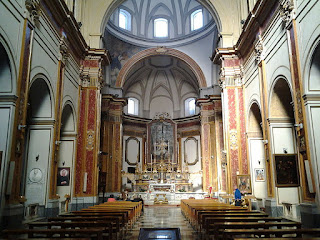NEW - Leonardo Leo - composer
Baroque musician known for his sense of humour
A prolific composer of comic operas, Leonardo Leo was born on this day in 1694 in San Vito degli Schiavoni (now known as San Vito dei Normanni) in Apulia. His most famous comic opera was Amor vuol sofferenza - Love requires suffering - which he produced in 1739. It later became better known as La finta frascatana, and received a lot of praise, but Leo was equally admired for his serious operas and sacred music. He has been credited with forming the Neapolitan style of opera composition. He was enrolled as a young boy as a student at the Conservatorio della Pietà dei Turchini in Naples and was a pupil first of Francesco Provenzale and later of Nicola Fago. It has been speculated that he may have been taught by Alessandro Scarlatti, but it has since been proved by music historians that he could not possibly have studied with the composer, although he was obviously influenced by his compositions. Leo’s earliest known work was a sacred drama, L’infidelta abbattuta, which was performed by his fellow students in 1712, while he was still a teenager. His first opera, Pisistrato, was produced at the court theatre in Naples in 1714 and was much admired. Read more…
______________________________________
Felice Casson - politician and magistrate
His investigations revealed existence of Operation Gladio
Felice Casson, the magistrate whose investigations exposed the existence of the NATO-backed secret army codenamed Gladio, was born on this day in 1953 in Chioggia, near Venice. A former mayor of Venice and a representative of the Democratic Party in the Italian Senate, Casson devoted much of his career in the judiciary to fighting corruption and rooting out terrorists. In 1984, his interest in terrorism led him to examine the unsolved mystery of the Peteano bombing in 1972, in which three Carabinieri officers were killed by a car bomb placed under an abandoned Fiat 500 in a tiny hamlet close to the border with Yugoslavia in the province of Gorizia. Casson discovered flaws in the original investigation into the bombing, which at the time was blamed on the left-wing extremist group the Red Brigades, who would later be responsible for the kidnap and murder of Aldo Moro, a former prime minister. Afterwards, Italy launched a nationwide crackdown on left-wing organisations and made more than 200 arrests. But Casson found no record of any investigation of the scene of the bombing. Read more…
______________________________________
Antonio Barberini – Cardinal
Pope’s nephew amassed fortune and became patron of the arts
Catholic cardinal, military leader and patron of the arts Antonio Barberini was born on this day in 1607 in Rome. As one of the cardinal-nephews of Pope Urban VIII he helped to shape the politics, religion, art and music of 17th century Italy and took part in many papal conclaves. He is sometimes referred to as Antonio the Younger, or Antonio Barberini Iuniore, to distinguish him from his uncle, Antonio Marcello Barberini. Antonio was the youngest of six children born to Carlo Barberini and Costanza Magalotti. Like his brothers, he was educated at the Collegio Romano. His brother, Francesco Barberini, became Grand Inquisitor of the Roman Inquisition. His uncle, Maffeo Barberini, was elected as Pope the day after Antonio’s 16th birthday and became Pope Urban VIII. Urban VIII was notorious for nepotism and he appointed Antonio as a cardinal just after his 20th birthday. Nepotism was commonplace among popes from the Middle Ages up to the 17th century. The word derives from the Latin nepos (Italian: nipote), meaning nephew, to describe the practice among popes, who had taken vows of chastity and therefore could have no legitimate children, of appointing nephews to key positions. Read more…
____________________________________
Franco Lucentini – author
Writer was one half of a famous literary partnership
The novelist Franco Lucentini, who achieved success with Carlo Fruttero in a remarkable literary association, died on this day in 2002 in Turin. A news correspondent and editor, Lucentini met Fruttero in 1953 in Paris and they started working together as journalists and translators. But they were best known for the mystery thrillers they produced together, which they composed in a businesslike manner. After choosing a subject they would take it in turns to write and then edit the material until a novel was complete. Their most popular books were The Sunday Woman (La donna della domenica), which was later made into a film and The D Case (La verità sul caso D), which was based on an unfinished work by Charles Dickens, The Mystery of Edwin Drood. Lucentini fell foul of the Fascist regime while studying Philosophy at the University of Rome because of distributing anti-war messages among his fellow students and had to spend two months in prison. But after the Second World War he was hired by the Allies to work as a junior editor for their news agency in Naples. Lucentini then went on to work in Rome for Italy's ANSA news agency. Read more…
_____________________________________
Antonio Cesti – opera composer
Singer and organist wrote operas and church music
Composer Pietro Marc’Antonio Cesti was baptised on this day in 1623 in Arezzo in Tuscany. It was also probably the date of his birth. One of the leading composers of the 17th century, Cesti is said to have written about 100 operas, although only 15 are known today. He joined the order of Friars Minor, or Franciscans, a Catholic religious group founded by St Francis of Assisi in 1637. Cesti studied first in Rome and then moved to Venice, where his first known opera, Orontea, was produced in 1649. In 1652 he became chapel master to Archduke Ferdinand of Austria at Innsbruck and from 1669 he was vice chapel master to the imperial court in Vienna. Throughout the 17th century his operas were widely performed in Italy. His most famous operas, Il pomo d’oro, Dori and Orontea, have survived to this day. Il pomo d’oro was a lavish production, written for the wedding of Emperor Leopold I in 1666 in Vienna. An important manuscript collection of 18 secular and three sacred cantatas by Cesti are preserved in Oxford. His cantatas and religious works show Roman influences, whereas his operas demonstrate the influence of the Venetian school. Read more…
Booking.com.png)

.jpg)



.png)



.jpg)
.jpg)
.jpg)

.jpg)
